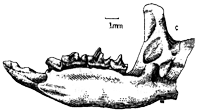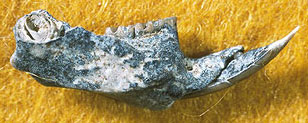Shrew
 Big
fossils like dinosaurs, mammoths, camels and horses get more than their fair
share of attention. Most museum displays are centered around an impressively
large skeleton, preferably in a dramatic pose. Certainly we are no exception
at the fossil beds - just walk into our visitor center and what is the first
thing you'll see? A skeleton of the Hagerman Horse!
Big
fossils like dinosaurs, mammoths, camels and horses get more than their fair
share of attention. Most museum displays are centered around an impressively
large skeleton, preferably in a dramatic pose. Certainly we are no exception
at the fossil beds - just walk into our visitor center and what is the first
thing you'll see? A skeleton of the Hagerman Horse!
From an ecological standpoint, big animals are over-rated. In
any modern ecosystem there are more small animals than large. Think about it, if you have
an acre of land, how many bison can you raise compared to the number of mice or other
small mammals? Obviously the number of small animals will greatly outnumber the number of
large ones for any parcel of land. This was also true in ancient ecosystems and because of
the large number of individuals there is actually a greater chance for small animals to be
preserved as fossils than larger ones.
At Hagerman Fossil Beds we are fortunate to have preserved a
diversity of fossil animals that includes the small as well as the large. Among the
smallest of living mammals today are the shrews. Five species of fossil shrews have been
found at Hagerman, four are in the genus Sorex and one in Paracryptotis.
Today there are six species of shrew in the modern fauna of Idaho all in the genus Sorex.
 All
of the shrew species at Hagerman are extinct and it is difficult to determine
how closely related any of them are to the living species in the state. In fact
four of the species are known only from Hagerman and have not yet been identified
at any other fossil localities in the country. This may reflect a limited geographic
distribution of these species, possibly confined to the Snake River Plain, or
simply that their small size has kept them from being recovered at other fossil
localities.
All
of the shrew species at Hagerman are extinct and it is difficult to determine
how closely related any of them are to the living species in the state. In fact
four of the species are known only from Hagerman and have not yet been identified
at any other fossil localities in the country. This may reflect a limited geographic
distribution of these species, possibly confined to the Snake River Plain, or
simply that their small size has kept them from being recovered at other fossil
localities.
Finding the fossil can be a challenge. Given their small size
(a shrew jaw for example is only 11 mm long or less than 1/2 inch) it is often hard to see
them on the ground unless you are crawling on your hands and knees with your nose just a
few inches above ground level, so unless you are really paying attention they are easy to
miss. If you are used to looking for big bones which are easy to spot, looking for small
animals like shrews takes some adjustment of your "search image".
Paleontologists often improve their chances of finding small animals like shrews by
collecting large samples of sediments and running them through a fine mesh screen. The
finer sediments pass through leaving behind the larger (relatively) pieces like shrew
jaws. While this may improve your chances of getting small animals, if the site is not
very rich with bone it sometimes requires running tons of sand through the screen to get a
decent sample.

Although there may be lots of small animals in an area to
become fossils, their small bones can be easily broken and not preserved, especially when
predators eat them. While skulls are easily destroyed the palate often remains intact and
jaws often survive as well. It is fortunate that teeth in palates and jaws are preserved
since they are the most distinctive part of the animal. It is these parts of the animal
that paleontologists look at most closely to decide which species they have. In fact all
five of the species of shrew found at Hagerman were first described in the scientific
literature based on jaws.
As research continues at Hagerman we hope to increase our
sample and knowledge about each of these species. Perhaps eventually some of these species
will be found in other fossil faunas and improve our knowledge of their geographical
distribution. In any case just as in modern ecosystems where small animals play a big role
we are sure such was the case in the ancient Hagerman ecosystem. Each species of tiny
shrew has a story to tell that is just an exciting as that of the big critters.
 Big
fossils like dinosaurs, mammoths, camels and horses get more than their fair
share of attention. Most museum displays are centered around an impressively
large skeleton, preferably in a dramatic pose. Certainly we are no exception
at the fossil beds - just walk into our visitor center and what is the first
thing you'll see? A skeleton of the Hagerman Horse!
Big
fossils like dinosaurs, mammoths, camels and horses get more than their fair
share of attention. Most museum displays are centered around an impressively
large skeleton, preferably in a dramatic pose. Certainly we are no exception
at the fossil beds - just walk into our visitor center and what is the first
thing you'll see? A skeleton of the Hagerman Horse!  All
of the shrew species at Hagerman are extinct and it is difficult to determine
how closely related any of them are to the living species in the state. In fact
four of the species are known only from Hagerman and have not yet been identified
at any other fossil localities in the country. This may reflect a limited geographic
distribution of these species, possibly confined to the Snake River Plain, or
simply that their small size has kept them from being recovered at other fossil
localities.
All
of the shrew species at Hagerman are extinct and it is difficult to determine
how closely related any of them are to the living species in the state. In fact
four of the species are known only from Hagerman and have not yet been identified
at any other fossil localities in the country. This may reflect a limited geographic
distribution of these species, possibly confined to the Snake River Plain, or
simply that their small size has kept them from being recovered at other fossil
localities. 